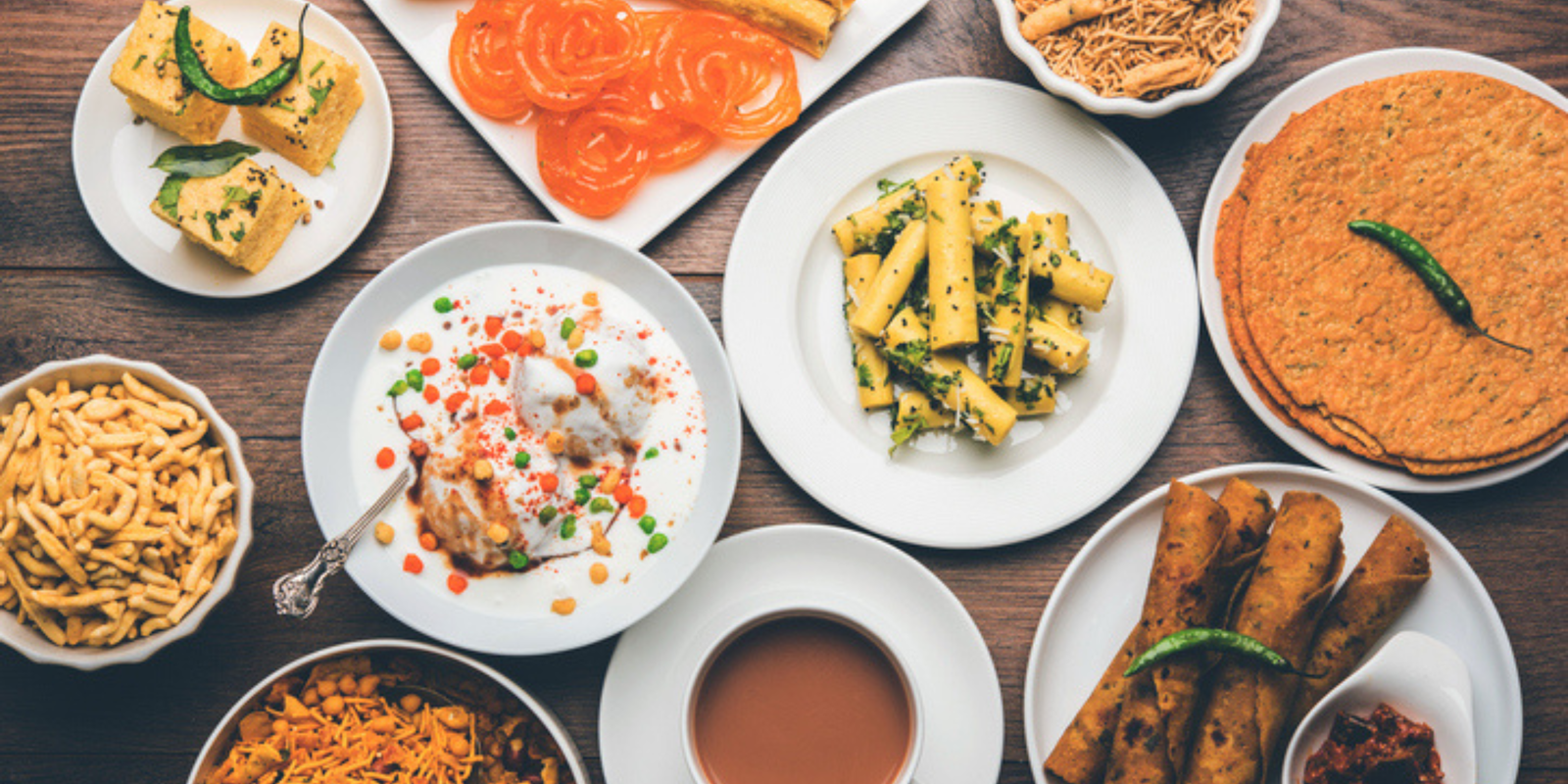

Dt. Natasha Mohan
Dietitian Natasha Mohan is one of the most influential and renowned nutritionist and dietitian, with over 3 Million Followers on YouTube and 200+ Million Views and with 10+ Years of Experience. Dietitian Natasha Mohan is a transformation expert, Motivational Speaker and Lifestyle Expert. She has touched million of lives. She specializes in Therapeutic Diets Like, PCOS/PCOD, Thyroid, Diabetes, Cholesterol, Blood pressure, and other lifestyle disorder.
Table of Contents
Gujarati diet for healthy living – 7-day meal plan
Why a Gujarati diet plan is important
A Gujarati diet plan include traditional and vegetarian cuisine that involve vegetarian ingredients such as dals, legumes, vegetables, grains, and dairy. Despite getting nutrients from meat or fish Gujarati diet plan ensure that ingredients are combined in a way that provides balanced nutrition, covering both micro and macronutrients.
Health benefits of Gujarati cuisine
Rich in plant-based nutrition – Gujrati food is mostly vegetarian with variety of dals legumes, seasonal fruits and vegetable which full fill nutrients deficiency for body to support immunity and overall health.
Support digestion – Gujarati cuisine uses fermented food like dhokla, handvo and khandvi with curd and buttermilk which are rich in probiotics that increase good gut bacteria in stomach that improve our digestion.
Balanced meals – Gujarati use variety of cuisine in one meal like dal, chawal, roti, sabzi, sweet and butter milk that is not only full fill body vitamins scarcity but also rich in taste.
Traditional eating habits in Gujarat
- Gujarati eating habits is the love for variety and balance in flavours.
- One meal includes combined vegetable sabzi, lentil, dal and sweets which keeps the cuisine interesting and rich in nutrients.
- Gujarati style dal includes jagger and sugar to blend flavour to keep balance between salty and sweetness.
Key elements of a balanced Gujarati
- Whole grains in Gujarati meals – Most of the Gujarati dishes include millet(bajra), wheat, rice, and jowar which are rich in carbohydrates that is eaten in the form of roti, thepla, khichdi or handvo that gives energy to body for work.
- Vegetables and legumes in daily diet – Variety of dals like Toor dal, moong dal and chana dal and seasonal veggies are part of most Gujarati dishes which has multiple sources of vitamins and minerals.
- Roles of spices and herbs in digestion – Spices like fennel seeds and carom seeds stimulate digestive juices and enzymes which make it easiest for the stomach to break down food. Thepla is one of dishes that every Gujarati like to add them either in their dinner and breakfast which include ajwain (carom seeds) that keep our digestion strong.
- Importance of dairy in Gujarati food – In traditional Gujarati meals dairy products like buttermilk, ghee, curd and milk are essential part of everyday meal. Which are sources of protein, calcium, and healthy fats.
7 days Gujarati diet plan
Day 1
Breakfast
- Classic Gujarati breakfast
- Steamed dhokla and glass of warm turmeric milk
Lunch
- Full Gujarati thali with balance
- Gujarati thalis include – roti, dal, seasonal Shaak, rice, salad, and chaas(butter milk).
Dinner
- Simple traditional dinner
- Khichdi and kadhi (light on the stomach and good for sleep).
Day 2
Breakfast
- Traditional gujarati breakfast
- Thepla with curd
Lunch
- Protein rich thali meals
- Moong dal, bhindi sabzi, roti, and buttermilk (protein rich gujarati diet while keeping meals balanced).
Dinner
- Low oil dinner options (healthy Gujarati dinner)
- Vegetable handvo with green chutney
Day 3
Breakfast
- Fiber-rich Gujarati
- Methi thepla with one glass buttermilk.
Lunch
- Variety in Gujarati thali
- Bajra rotla, mixed dal, seasonal sabzi, rice, salad, and chaas.
Dinner
- Wholesome and light (light Gujarati food)
- Vegetable khichdi with kadhi.
Day 4
Breakfast
- Quick Gujarati snacks
- Khandvi with mint chutney
Lunch
- Balanced meal with dal & sabzi
- Toor dal, aloo-methi sabzi, roti, rice, and buttermilk.
Dinner
- Healthy & easy to digest dinner
- Doodhi muthiya with kadhi.
Day 5
Breakfast
- Energy boosting Gujarati dishes
- Upma made from suji or vegetable poha. Both are great gujarati breakfast for energy and stamina.
Lunch
- Nutritious gujarati thali
- Rotis, dal, shaak, rice, picle, papad, salad, and chaas for a complete meal.
Dinner
- Light homemade gujarati food
- Moond dal khichdi with curd are home guarati food is filling very light.
Day 6
Breakfast
- Healthy traditional options
- Fada ni khicdi or idada both are tradtional gujarati breakfast.
Lunch
- Combination of dal, roti & vegetables (Gujarati dal roti diet)
- Rotis with mixed dal, seasonal shaak, rice and salad.
Dinner
- Low fat Gujarati dinner
- Oats thepla with vegetable soup.
Day 7
Breakfast
- Classic gujarati breakfast
- Fafda with papaya chutney or jalebi for dessert.
Lunch
- Full gujarati thali with balance
- Full Gujarati thali diet with roti, dal, shaak, rice, farsan, pickle(achaar), papad, sweet dish, and chaas for a festival meal.
Dinner
- Simple traditional dinner (Gujarati traditional dinner)
- Bajra rotla, garlic chutney with buttermilk.
Food to avoid in a Gujarati diet plan
- Fried snacks in excess: items like samosa, bhajia and fafda are deep fried and high in calories which can increase the bad cholesterol of the body.
- Too many sugary sweets: gujarati dishes always include meal ending sweets like jalebi, basundi, and mohanthal are delicious but high in sweet and ghee that keep that body lethargic.
- Overuse of oil & ghee: Gujarati sabzis often cooked with excess oil, butter and cream which is heavy preparation daily is not good for Gujarati diet plan.
Lifestyle tips to follow with a Gujarati diet
- Hydration with traditional drinks: you can replace soft drinks or sugary juices with chaas(buttermilk) or nimbu pani that will keep your body hydrated and detoxify the body.
- Importance of portion control: Gujarati vegetarian meal plan has variety of items include rotis, rice, sabzi, dal, farsan and chutney which are rich in nutrients, but you should consume all of them in small portion so you can avoid health issue from one type of food.
- Daily exercise and active lifestyle: exercise is important part of our daily routine even after eating balanced Gujarati meals and any type of meal. That keeps your body fit and healthy.
Conclusion
I have mentioned 7 – days Gujarati diet plan for healthy eating this will full fill your all-nutritional values in your body and maintain the metabolism for rest. Gujarati cuisine includes much oil, ghee and butter but in moderation you can avoid them for health benefits. If you eat balanced Gujarati meals under the guidance of dietitian that will keep you healthy for long time. If you are struggling to manage your weight I can prepare Gujarati diet chart for weight loss for 7 days.
Yes, Gujarati food is healthy when prepared with minimum oil and eating farsan and sweets in controlled portion and focus on more vegetable, dals and whole grains for health benefits.
You can avoid more fried food like bhajia, fafa and kachori and heavy sweet like Shrikhand you can consume them in occasions but if you are struggling with health issue then you should completely avoid them.
Buttermilk is a daily staple in Gujarati vegetarian meal plan which support good gut bacteria that improves digestion.
Instead of use oily gravies and fried snacks you can add minimum oil in khichdi with kadhi and doodh muthiya to make it much lighter for dinner.
Sweets like shrikhand, basundi or mohanthal are tradtional gujarati sweets that can be eaten once or thrice a week in small portions as part of balanced diet.


